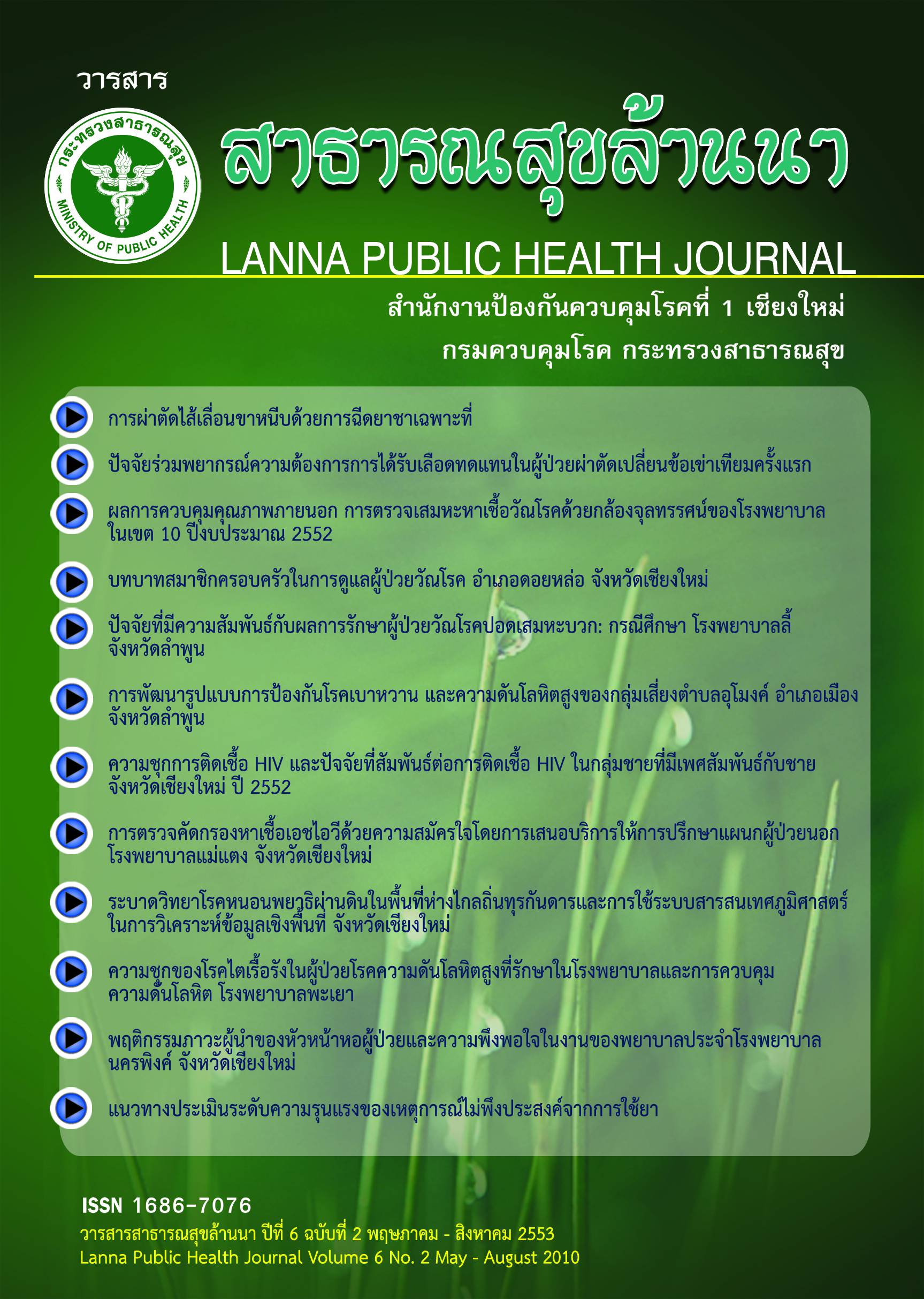ปัจจัยร่วมพยากรณ์ความต้องการการได้รับเลือดทดแทนในผู้ป่วยผ่าตัดเปลี่ยนข้อเข่าเทียมครั้งแรก
คำสำคัญ:
การผ่าตัดเปลี่ยนข้อเข่า, การสูญเสียเลือดจากการผ่าตัด, การได้รับเลือดทดแทนบทคัดย่อ
การสูญเสียเลือดในผู้ป่วยผ่าตัดเปลี่ยนข้อเข่าเทียม เป็นสิ่งที่ศัลยแพทย์ควรให้ความสำคัญ มีหลายการศึกษาที่แสดงถึงปริมาณการสูญเสียเลือดซึ่งอาจมีได้ถึง 1,500 มิลลิลิตรในการผ่าตัดเปลี่ยนข้อเข่าเทียมครั้งแรก การสูญเสียเลือดนั้นมีผลกระทบติดตามมาอย่างต่อเนื่อง และบ่อยครั้งที่ผู้ป่วยต้องได้รับเลือดทดแทน การศึกษาถึงปัจจัยที่เกี่ยวข้องช่วยให้ได้ข้อมูลที่เป็นประโยชน์ในการลดอัตราการได้รับเลือดทดแทน และเพื่อพัฒนาคุณภาพการรักษาวัตถุประสงค์ เพื่อศึกษาอัตราการได้รับเลือดทดแทนในผู้ป่วยผ่าตัดเปลี่ยนข้อเข่าเทียมครั้งแรกและปัจจัยที่เกี่ยวข้อง รูปแบบการศึกษา การศึกษาแบบ Retrospective cohort study สถานที่ศึกษา แผนกศัลยกรรมออร์โธปิดิกส์ โรงพยาบาลลำพูน วิธีการศึกษา รวบรวมข้อมูลผู้ป่วยทุกรายที่ได้รับการผ่าตัดเปลี่ยนข้อเข่าเทียมครั้งแรกจำนวน 73 ราย ตั้งแต่เดือนเมษายนถึงเดือนกันยายน 2552 ศึกษาอัตราการได้รับเลือดทดแทน และปัจจัยที่เกี่ยวข้อง วิเคราะห์ความแตกต่างของผู้ป่วยที่ได้รับและไม่ได้รับเลือดทดแทนด้วย chi-square test และ t-test วิเคราะห์ค่าความเสี่ยงของปัจจัยร่วมพยากรณ์ด้วย univariable log risk regresstion และ ช่วงความเชื่อมั่น 95% ทดสอบอิทธิพลอิสระของปัจจัยร่วมพยากรณ์ด้วย multivariable log risk regression
ผลการศึกษา ปัจจัยร่วมพยากรณ์การได้รับเลือดทดแทนภายหลังการผ่าตัดได้แก่ ผู้ป่วยที่มีอายุ ≥ 70ปี(RR=4.44,P=0.028) ระยะเวลาการผ่าตัด ≥ 91 นาที(RR=11.33, P=0.047) การปล่อย Tourniquet เพื่อห้ามเลือด (RR=4.60, P=0.007) ความดันของ Tourniquet 400 มิลลิเมตรปรอท (RR=3.45, P=0.028) การเปลี่ยนกระดูกสะบ้าหัวเข่า (RR=2.76, P=0.033) และการสูญเสียเลือดภายหลังการผ่าตัด ≥ 801มิลลิเมตร (RR=4.44, P=0.028) จากการวิเคราะห์ด้วย multivariable log risk regression พบปัจจัยที่เพิ่มความเสี่ยงของการได้รับเลือดทดแทน เพียงอย่างเดียวคือ การปล่อย Tourniquet เพื่อห้ามเลือดอาจเป็นวิธีการที่ไม่มีประสิทธิภาพในการลดการสูญเสียเลือดจากการผ่าตัด
เอกสารอ้างอิง
Lemos MJ,Healy WL, Blood transfusion in orthopedic operations. J Bone Joint Surg Am. 1996; 78.
Knight JL, Sherer D, Guo J. Blood transfusion strategies for total knee arthroplasty: minimizing autologous wastage, risk of homologous blood transfusion, and transfusion cost. J Arthroplasty.1998; 13: 70-76.
Berman AT, Geissele AE, Bosacco SL. Blood loss in total knee arthroplasty. Clin Othop Relate Res. 1988: 137-138.
Lotke PA, FarlliVJ, Orenstein EM, et al. Blood loss after total knee replacement. Effects of tourniquet release and continuous passive motion. J Bone Joint Surg Am 1991; 73: 1037-1040.
Perioperative Blood Transfusion Is Predictive of Postaternotomy surgical site infection: mrker for morbidity or true immunosuppressant? Talbot TR, D’Agata EM,Brinsko V, et al. Clinical Infectious Diseases 2004; 38: 1378-82.
Lavy O, Martinowitz U, Oran A, et al. The used of fibrin tissue adhesive to reduce blood loss and the need for blood transfusion after total knee arthroplasty. A prospective, randomized, multicenter study.J Bone Joint Surg Am. 1999; 81: 1580-1588.
Birkmeyer JD, Goodnough LT, Aubuchon JP, et al. The cose-effectiveness of preoperative autologous blood donation for total hip and knee replacement.
Tang R, Chem HH. Wang YL, et al. Risk factors fo5r surgical site infection after elective resection of colon and rectum: A single-center prospective study of 2809 consecutive patients. Ann Surg 2001; 234(2): 181-189.
Murphy P, Heal JM, Blumberg N. Infection or suspected infection after hip replacement surgery with autologous or homologous blood transfusion. Transfusions. 1991; 31: 212-217.
Vandenbussche E, Duranthon LD, Couturier M, et al. The effect of tourniquet use in total knee arthroploasty. Int Othop. 2002; 26: 306-309.
Tria AJ Jr. Coon TM. Minimal incision total knee arthroplasty; early experience. Clin Othop. 2003; 416: 185-190.
Ko PS, Tio MK, Tang WL, el al. Sealing the intramedullalry femoral canal with autologous bone plug in total knee arthroplasty. J Arthroplasty. 2003; 18: 6-9.
Ong SM, Taylor GL. Can knee position save blood following total knee replacement. Knee.2003; 10: 81-85.
Samama CM. A direct antifibrinolytic agent in major orthopaedic surgery. Othipedies.2004; 27(6 Suppl): 675-680.
Raut VV, Stone MH, Wroblewski RM, Reduction of postoperative blood loss after press-fit condylar knee arthroplasty with use of a femoral intramedullary plug. J Bone and Joint Surg. 1993; 75: 1356-1357.
Albery GM, Matthew PF, Daniel EM, et al. Perioperative blood loss associated with total knee arthroplasty. J Bone Joint Surg am. 1990; 72: 1010-1012.
Benoni G, Fredin H. Fibrinolytic inhibition with transexamin acid reduces blood loss and blood transfusion after knee arthroplasty. J Bone Joint Surg Br.1996; 78: 434-440.
Cushner FD, Friedman RJ. Blood loss in total knee arthroplasty. Clin Othop Relat Res. 1991; 269-298.
Tanaka N, Sakahashi H, Sato E, et al. Timming of the administration of transexamic acid for maximum reduction in blood loss in arthroplasty of the knee. J Bone Joint Surg Br. 2001; 83: 702-707.
Bierbaum BE, Callaghan JJ, Colante JO, et al. An analysis of blood management in patients having a total hip or knee arthroplasty. J Bone Joint Surg Am 1999; 82: 2-10.
Land A, Crosby ET. Blood management for hip reconstruction surgery. Orthop Clin N Am 2009; 40: 417-425.Zuffery P Morquial F, Laporte S, et al. Do antifibrinolytics reduce allogeneic blood transfusion in orthopedics surgery? Anesthesiology 2006; 105: 1034-46.
Cid J, Lozano M. Tranesamic acid reduced allogeneic red cell transfusion in patients going total knee arthroplasty: results of meta-analysis of randomized controlled trials. TRANSFUSION 2005; 45: 1302-1307.
Herseki MA, Akpinar S, Ozkoc G, et al. The timing of tourniquet released and its influence on blood loss after total knee arthroplasty. Int Othop. 2004; 28: 138-141.
Jorn LP, Lindstrand A, Toksvig-Larsen S. Tourniquet release increase bleeding. A randomized study of 77 knee replacement. Acta Othop Scand. 1999; 70: 256-267.
Christodoulou AG, Plounmis AL, Terzidis IP, et al. The role of timing of tourniquet release and cementing on perioperative blood loss in total knee replacement. Knee. 2004; 11: 313-317.
Rama KR, Apsingi S, Poovali S, et al. Timing of tourniquet release in knee arthroplasty. Meta-analysis of randomized, controlled trials. J Bond Joint Surg Am. 2007; 89; 699-705.








